Food
International Association of People Who Dine Over the Kitchen Sink
Norm Hankoff had the idea for the "International Association of People Who Dine Over the Kitchen Sink" in 1991, while he was standing at the sink using potato chips to spoon tuna salad into his mouth.The next year he founded the Association. He referred to its members as 'sinkies'. Then, in 1994, he came out with The Official Sinkies Don't Cook Book, which included "recipes" such as:
- cakeless frosting
- a handful of mashed potatoes
- a cracker topped with mayo, then another cracker, then American cheese, then another cracker, mustard, cracker, pickle chip, cracker and Swiss cheese
- chocolate cake in a glass of milk
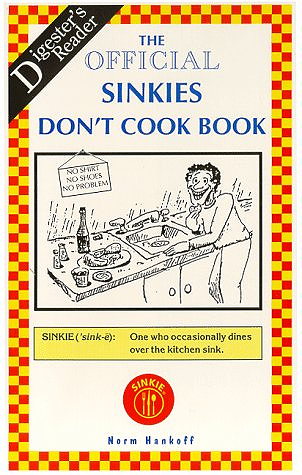
Amazon Link
The Association still exists. Or, at least, it still has a website: sinkie.com.
Sinkies consider the day after Thanksgiving to be their annual holiday. They call it "Dine Over Your Kitchen Sink Day".
Posted By: Alex - Thu Nov 25, 2021 -
Comments (0)
Category: Clubs, Fraternities and Other Self-selecting Organizations, Food, Thanksgiving
Happy Thanksgiving 2021!
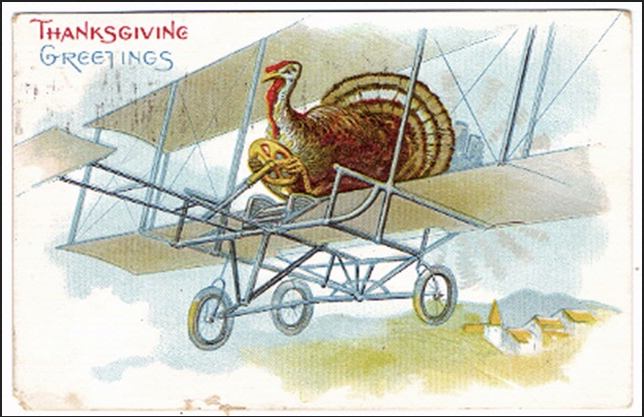
Posted By: Paul - Thu Nov 25, 2021 -
Comments (3)
Category: Anthropomorphism, Food, Holidays, Air Travel and Airlines
Chicken-Feather Cookies
We've posted before about weird things that food scientists have made flour out of, including sawdust, fish, and (of course) insects. Add chicken feathers to that list.In 1976, Dr. A.L. Shewfelt of the University of Georgia experimented with transforming chicken feathers into a "highly digestible creamy-white powder" and then using this to make cookies. Most of the taste testers said the cookies were "pretty good," except for one who complained of a soapy taste — a result of the chemical solvent the feathers had been washed in.
I think the lesson here is that almost anything can taste okay if you turn it into a powder and add enough sugar to it.

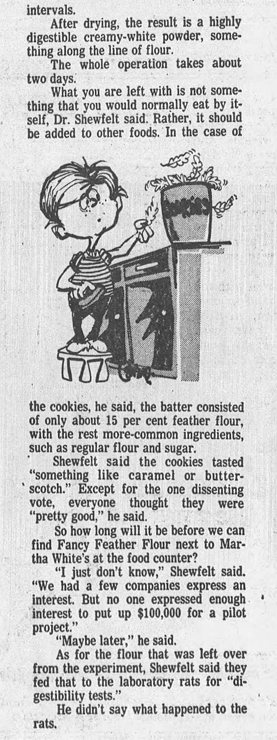
The Atlanta Constitution - Mar 9, 1976
Posted By: Alex - Tue Nov 23, 2021 -
Comments (1)
Category: Food, 1970s
Jello Brainwaves
In 1974, Dr. Adrian Upton of McMaster University placed E.E.G. electrodes on a blob of lime jello and obtained positive readings. This indicated brain activity. He published his results in 1976 in the Medical Tribune.Upton was trying to demonstrate that when doctors use an E.E.G. to determine brain death, it can be difficult to obtain a perfectly flat readout, because the equipment picks up stray electrical activity from the surrounding environment. Or maybe he had discovered that jello is a sentient lifeform.
The Jell-O Gallery Museum in Le Roy, New York seems to prefer the latter conclusion. A brain-shaped jello mold on display at the museum bears the message: "A Bowl of Jell-O Gelatin and the Human Brain Have the Same Frequency of Brain Waves."

image source: Donna Goldstein, researchgate.net
More info: The Straight Dope

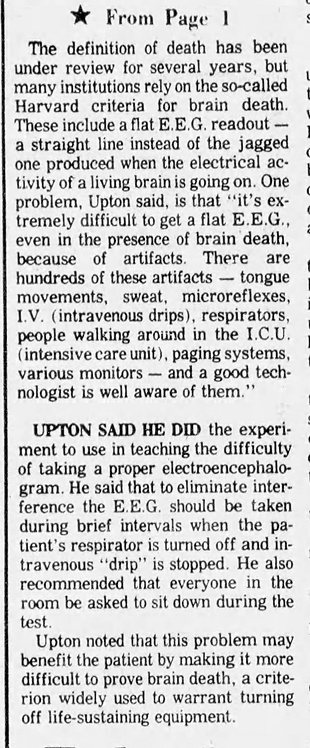
Wichita Eagle - Mar 8, 1976
Posted By: Alex - Mon Nov 15, 2021 -
Comments (7)
Category: Food, Jello, Experiments, 1970s, Brain
Dormice as a delicacy
Recently in the news:The small rodents are believed to be a mafia delicacy served at important banquets. They were found when officers searched outbuildings of a cannabis farm in Reggio Calabria on Saturday.
Apparently dormice have been considered a delicacy since Roman times. Seconds Food History offers some info:
Back in the 1970s, Richard Hunt of High Lane, England had a business selling frozen dormice, "electrocuted and carefully skinned," for $51 each. That would be over $200 each, in today's dollars.
Dormice subsequently became protected under EU law, which must have ended Hunt's business. But has Brexit made it legal again to sell dormouse meat in the UK? I don't know.

Fort Worth Star Telegram - Aug 4, 1977
Posted By: Alex - Sun Nov 07, 2021 -
Comments (0)
Category: Food
Kentucky Roast Beef
Here's a neat article about this failed venture by Colonel Sanders.You won't find the image below at that page.
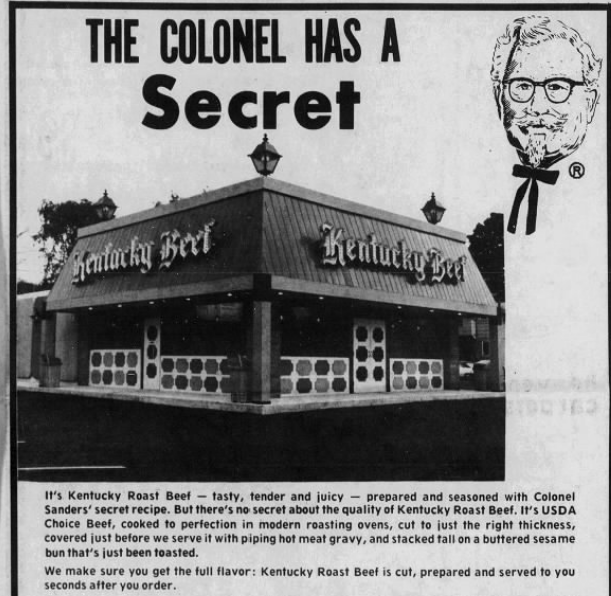
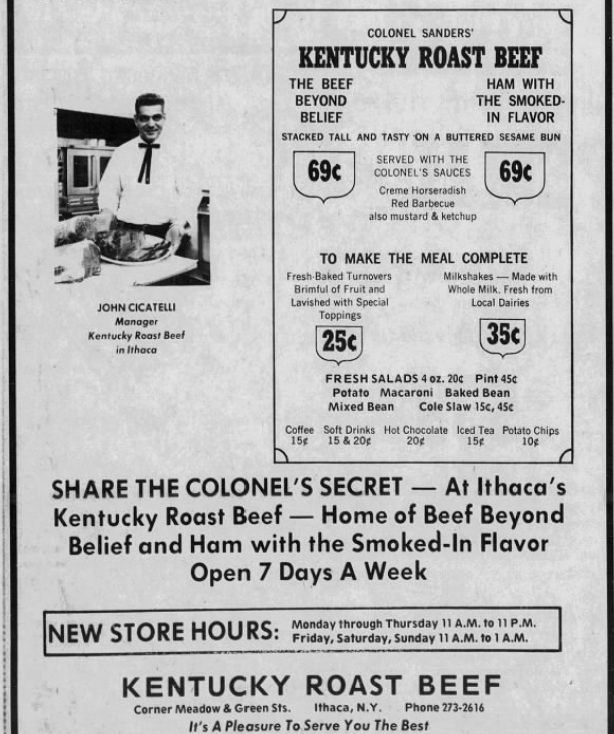
Posted By: Paul - Thu Oct 21, 2021 -
Comments (3)
Category: Business, Advertising, Food, Success & Failure, 1960s
Richard Nixon, Cottage Cheese, and Ketchup
Richard Nixon's favorite snack was reportedly cottage cheese topped with ketchup.A 1960 article in the LA Times treated this as noncontroversial personal information about the then-presidential candidate, noting that he had acquired a taste for this unusual delicacy from his Quaker grandmother.

Los Angeles Times - Mar 14, 1960
However, by the 1970s Nixon's team was downplaying his fondness for this snack. Helen Smith, the first lady's press secretary, dismissed it as overblown rumor.

Casper Star Tribune - June 5, 1973
Similarly, White House chef Henry Haller, in his book The White House Family Cookbook, denied he had ever seen Nixon eat such a concoction: "If the President ever doused his cottage cheese with catsup, I never saw him, and doubt he ever did."
I suspect the truth is that Nixon enjoyed this snack when he was younger, but didn't continue eating it when he was President. Regardless, the combination of cottage cheese and ketchup was definitely associated with Nixon in the public mind, and it inspired one odd work of art.
In 1973, on the eve of Nixon's second inauguration, the sculptor Carl Andre dumped 500 pounds of cottage cheese on the floor of the Max Protetch gallery in Washington, DC. He then topped this with 10 gallons of ketchup. He called the work 'American Decay'. However, it smelled so bad that it all had to be removed the next day.
More info: Interview Magazine

'American Decay'. Image source: bonhams
Posted By: Alex - Mon Oct 18, 2021 -
Comments (0)
Category: Art, Food, Politics, 1970s
Gastro Obscura
A new book from the ATLAS OBSCURA folks about weird foods. A perfect Xmas present for any WU-vie!I understand Jeppson's Malört is discussed therein.
Posted By: Paul - Thu Oct 14, 2021 -
Comments (1)
Category: Food, Regionalism, World, Nausea, Revulsion and Disgust
Long Eggs
Long eggs are either: a) eggs laid by specially bred long chickens; or b) a highly engineered food product created in the 1970s to satisfy the food service industry's desire to have egg slices with a consistent ratio of white and yolk.You can choose what you want to believe.

source: shemazing.net
The video below shows how long eggs might be engineered. It's in German, but even if you don't speak that it's easy to understand what's going on.
Posted By: Alex - Mon Oct 04, 2021 -
Comments (5)
Category: Food, Eggs
Killer Tomatoes
My partner grafts tomatoes for our garden. Must caution against this!Source: The Knoxville News-Sentinel (Knoxville, Tennessee) 31 Oct 1963, Thu Page 14
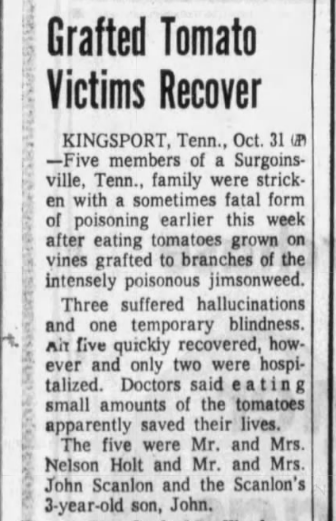
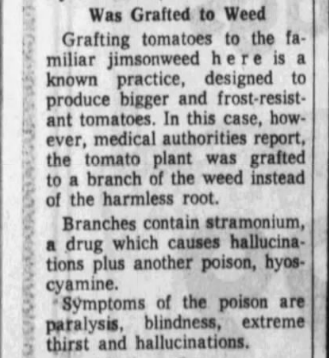
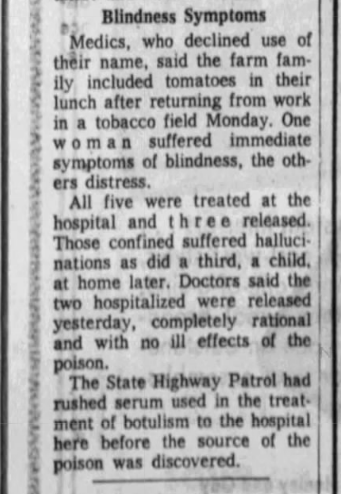
Posted By: Paul - Thu Sep 16, 2021 -
Comments (2)
Category: Family, Food, Psychedelic, 1960s, Goofs and Screw-ups

| Who We Are |
|---|
| Alex Boese Alex is the creator and curator of the Museum of Hoaxes. He's also the author of various weird, non-fiction, science-themed books such as Elephants on Acid and Psychedelic Apes. Paul Di Filippo Paul has been paid to put weird ideas into fictional form for over thirty years, in his career as a noted science fiction writer. He has recently begun blogging on many curious topics with three fellow writers at The Inferior 4+1. Contact Us |




